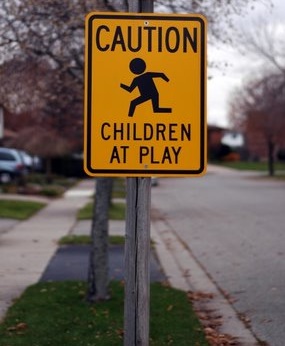Are “Children at Play” signs as helpful as we think?
We’ve all seen it: the yellow advisory sign with some variation of the words “Caution: Children at Play” and a graphic of a child engaged in some sort of activity. Most parents are comforted by the presence of these signs, assuming they create a safer environment for children to play outside. However, despite their abundance, these signs have not been proven to change driver behavior or increase the safety of children.

In a Slate Magazine article, Tom Vanderbilt explains the reasons why he and other engineers dislike these advisory signs. First is the fact that if a driver is driving through an area where there are children playing, they will likely notice the children playing before they would notice a sign warning of the children. Furthermore, if a driver does not recognize the characteristics of an area where children are likely to be playing and adapt their driving behavior accordingly, then it is unlikely that they would notice or obey an advisory sign.
Vanderbilt also points out that the majority of the time that a driver encounters these “Children at Play” signs, they will not be accompanied by an actual presence of children playing. This conditions drivers to disregard the warning. The Manual of Uniform Traffic Control Devices (MUTCD) shares this sentiment, noting that “the use of warning signs should be kept to a minimum as the unnecessary use of warning signs tends to breed disrespect for all signs.”
Additional concerns presented in the article are that the signs imply that there are not children at play in other areas, that they breed a false sense of security for parents and children, and that they encourage the idea that the street is to be used as a play area.
Thus, if speeding on residential roads is a problem, but advisory signs are not an effective means of eliminating this problem, then what is the solution? According to Vanderbilt, it is road design, not road signage, that primarily dictates how people drive. Vanderbilt concludes that simply removing these signs is not enough; they must be replaced with more compelling ways of lowering speed, such as narrower roads, the elimination of unnecessary center-line markings, and the presence of calming obstacles, such as trees and bulb-outs.






